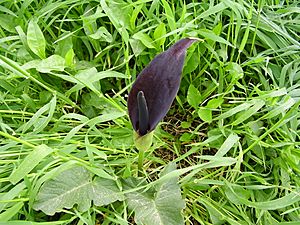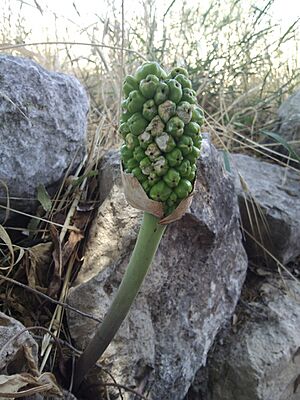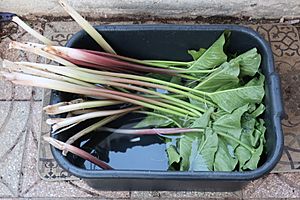Arum palaestinum facts for kids
Quick facts for kids Arum palaestinum |
|
|---|---|
 |
|
| Scientific classification | |
| Genus: |
Arum
|
| Species: |
palaestinum
|
| Synonyms | |
|
|
Arum palaestinum is a type of flowering plant that grows year after year. It belongs to the Araceae family, which also includes popular plants like Anthurium and Philodendron. You might know it by other names like black calla, Solomon's lily, or priest's hood.
This plant originally comes from the Middle East and other areas around the Mediterranean Sea. It has also started growing naturally in places like North America, North Africa, Europe, and Australia. Arum palaestinum is famous for its long history in the Middle East, where people have used it as food and in traditional medicines.
Contents
What is Arum palaestinum?
This plant usually grows about 10 to 25 centimeters (4 to 10 inches) tall. It blooms in the spring, typically in March and April. When it blooms, it's easy to spot because of its unique flower.
The flower has a dark purplish-black part called a spadix. This spadix is wrapped inside a reddish-brown leaf-like part called a spathe. The leaves of Arum palaestinum are light green, narrow, and stand upright. The plant grows from a round, underground stem called a tuber.
How it Spreads Pollen
Like other plants in the Arum family, Arum palaestinum gives off a special smell. This smell attracts flies, which then help spread the plant's pollen. While many Arum plants smell like rotting meat, this one can also smell like rotting fruit.
The plant's Latin name, palaestinum, comes from Palestine. It is native to the Levant and other parts of the Mediterranean region. It has also spread and now grows in North America, North Africa, Europe, Western Asia, and Australia.
Is Arum palaestinum Safe?
Arum palaestinum can be harmful if you eat it raw or in large amounts. This is because its leaves contain natural chemicals that can be toxic.
If you touch the raw plant, it might irritate your skin or cause a burning feeling. If someone eats too much of the raw plant, they might feel sick, have diarrhea, or stomach cramps. Because of this, people often handle the plant carefully or wear gloves.
To make the plant safe to eat, its leaves and roots must be cooked very well. This process helps remove the harmful chemicals.
History of Arum palaestinum
This plant has a very old history! Drawings of Arum plants have been found in the Temple of Thutmose III in Karnak, Egypt. These drawings show the plants being brought from Canaan way back in 1447 BCE.
The plant is also mentioned in the Mishnah, an ancient Jewish text. This text describes how people grew Arum palaestinum and used it as food.
A Greek thinker named Theophrastus, who lived a long time ago, wrote about plants. In his book Enquiry into Plants, he explained that the roots and leaves of Arum needed to be washed and cooked properly before they could be eaten. This shows that people knew about its special preparation needs even then.
How People Use Arum palaestinum
As Food
In Middle Eastern cooking, the leaves of Arum palaestinum are a popular ingredient. They are usually cut into pieces and cooked thoroughly. Often, lemon or sorrel is added to them.
People also use the leaves in soups. It's common to eat cooked Arum palaestinum with flat bread or bulgur (a type of cracked wheat). Some people say it tastes a bit like Swiss chard.
In Traditional Medicine
For a long time, people in the Middle East have used Arum palaestinum in their traditional medicines. For example, some Arab communities in Palestine used extracts from the plant for various health issues. These included helping with infections, kidney stones, and strengthening bones.
Jewish communities in Iraq also used it for things like skin sores, muscle pain, and diarrhea. It has also been used to help with coughs and constipation. Studies have shown that Arum palaestinum was one of the most commonly used plants for medicine in the West Bank.
Images for kids
See Also




